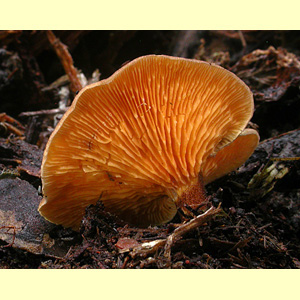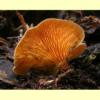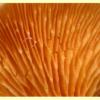
images/Hygrophoropsis/Hygrophoropsis_TM_DSCN7060.jpg
Small to large agaric, growing on the ground (rarely on litter or wood) with white or cream spore print. Pileus plane to infundibuliform, pale, yellow, orange or brown, not viscid, not hygrophanous, not translucent-striate. Lamellae decurrent, forked. Stipe central, rarely excentric. Partial veil remnants absent. Spores hyaline or pale, dextrinoid (in Australian species), smooth; germ pore absent. Cheilocystidia absent. Lamellar trama regular, interwoven or bilateral. Pileipellis a trichoderm. Clamp connections present.
Austropaxillus and
Paxillus are similar in fruit-body shape, and also often have forked lamellae, but they have a brown spore print.
Hygrophoropsis aurantiaca can have quite bright orange lamellae, as in a number of species of
Hygrocybe or
Cantharellus, but those other genera usually also have a brightly coloured pileus and stipe. Among agarics that grow on the ground and have a white spore print and decurrent lamellae, the smooth and dextrinoid spores of
Hygrophoropsis are unique. Fruit-bodies are also rather soft in texture, in contrast to the fleshy texture of other white-spored genera with decurrent lamellae such as
Clitocybe,
Hygrocybe and
Cantharellus.
Hygrophoropsis (J.Schröt.) Maire, in Martin-Sans, L'Empoisonnem. Champ. 99 (1929).
Two species:
Hygrophoropsis aurantiaca and
H. umbriceps.
According to Singer (1986), a few extra-Australian species have non-dextrinoid spores. The South Australian H. psammiphila which, according to Grgurinovic (1997), has pale, non-dextrinoid spores, is excluded pending an assessment of the spore print colour.
W.A., Qld, N.S.W., Vic. and Tas. (and possibly also N.T. and S.A.).
In native forest, including cool-temperate rainforest.
On the ground.
Saprotrophic.
Breitenbach, J. & Kränzlin, F. (eds) (1991),
Fungi of Switzerland.
Volume 3. Boletes and Agarics 1st part. Edition Mykologia, Lucerne. [
Illustration,
Description and
Microcharacters of
H. aurantiaca from Europe]
Corner, E.J.H. (1966), A monograph of cantharelloid fungi, Ann. Bot. Mem. 2: 1–255. [Key for species of the genus worldwide, and Description, B&W Illustration, Microcharacters of H. aurantiaca]
Fuhrer, B. (2005), A Field Guide to Australian Fungi. Bloomings Books, Hawthorn. [Description and Illustration of H. aurantiaca]
Horak, E. (1979e), Paxilloid Agaricales in Australasia, Sydowia 32: 154–166. [Description, B&W Illustration and Microcharacters of H. umbriceps from New Zealand]
May, T.[W.] (1989), Report of F.N.C.V. fungal excursions: 1986–1988, Vict. Naturalist 106: 48–58. [Description, B&W Illustration and Microcharacters of H. umbriceps]
McNabb, R.F.R. (1969), The Paxillaceae of New Zealand, New Zealand J. Bot. 7: 349–362. [Description and Microcharacters of H. umbriceps and H. aurantiaca (as H. coacta) from New Zealand, with B&W Illustration of the latter]



_AQ_23_sml.jpg)
